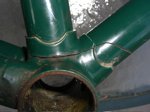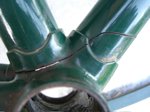Fifteen years ago, after having done a few long rides, including the Davis Double Century, I bought a bike I had developed a lust for (a lust, but only the chaste cycling kind). It was a Bridgestone RB-1, and was well-known for being a relatively light and sporty lugged steel road bike with a nice mix of components for a relatively modest price. I bought it at The Missing Link, a co-op shop in downtown Berkeley with a vague counterculture reputation, for about eight hundred dollars. I picked it up the week before the Grizzly Peak Century, a hilly 100-mile ride, and wondered during and after whether I had made a mistake. The bike worked fine, but it was geared sort of aggressively for a non-hill climber like myself. Back then, it wouldn’t have soon occurred to me to change the components to make it easier to ride, and I just got used to riding hills with what for me was an uncomfortably large smallest gear — 42×23 in cycling jargon (meaning my smaller front chainring had 42 teeth and my biggest rear cog had 23 teeth; in practical terms, that meant the rear wheel would turn about 1.85 times for every revolution of the cranks; that’s a big gear for a mere mortal struggling up a steep hill).
Since I bought the bike, I’ve had years where I rode a lot and many more when I did not. Sometimes the RB-1 would sit so long between rides that I had to dust it off before I took it out. But in 2003, when I decided to try to do Paris-Brest-Paris, the quadrennial 750-mile, 4-day ride in France, I decided I’d do it on the RB-1 rather than spring for a fancier and more expensive bike. By then, the bike had been out of production for nearly a decade, and it had sort of a cachet to it. I decided to strip off the original parts, have the bike repainted (by Ed Litton, a framebuilder up in Point Richmond), put new components on (including a triple crank with some low gears for when I started to fade) and ride it as new during the qualifying brevets leading up to PBP as well as during the main event. Ed’s paint job was simple but elegant — a dark green with a single ivory panel that displayed the Bridgestone decal. The bike’s spare, classic appearance and relative rarity — first that it was an RB-1, second that it was a lugged steel frame at a time they’re disappearing from the road in favor of titanium, carbon fiber and aluminum frames — drew some comment. Eventually, I, or maybe it was Kate, even gave it a name: Tir na nOg, Irish for “Land of the Young” (see the movie “Into the West” — the reference is explained there), which is where you get to on long, long bike rides.
PBP ’03 was a great experience, but then with one thing and another, I rode less in 2004 and 2005 before ramping up again this year in anticipation of PBP ’07. A couple months ago, though, I started to have some problems with Tir na nOg — the front derailleur seemed to not want to stay in adjustment. I fiddled with it myself, and so did more than one of the folks at The Missing Link. On April 1, I did a 300-kilometer brevet from Santa Cruz, through the mountains near town, and down to the Pinnacles and back. At the end of the ride, the shifting problem was bad. I put the bike aside afterward and have done some long rides since on my son Thom’s bike — a more modern steel Bianchi. I finally decided to take the RB-1 in to get looked at, again, yesterday. When I described what was going on, and how the crank seemed to be warped, Chuck, the mechanic, took a look at the frame near the bottom bracket.
“Here’s your problem,” he said. “You’ve got a cracked frame.” He pointed to a 1-inch fissure in the down tube — the diagonal one from the bottom bracket to the head tube. I couldn’t believe I hadn’t noticed it before, but then neither had anyone in the shop. Chuck said he’d strip the frame so I could bring it to a framebuilder for repair. I went back today, and he said, “I want to show you something.” Taking the components off the bike, he had discovered the crack ran a couple inches farther than we’d seen yesterday: Through the bottom-bracket lug where it receives the seat tube. The crack was so big I could see daylight through it. “I think it might be game over for this frame,” Chuck said — though he suggested I show it to a framebuilder in Oakland just to see whether there was any chance at fixing it. In any case, that’s the end of the long rides for this bike. As it happens, I have another freshly painted RB-1 frame I bought at the end of 2003 that’s just been sitting here in our house. I’ve been hesitant to spend the money to get it built up with all new components; now I’m going to have Chuck put it together with the gear from the old bike. If ti all works out, that will be my ride for next month’s Cascade 1,200 — a 750-miile, four-day ride in Washington state.
Technorati Tags: cycling


